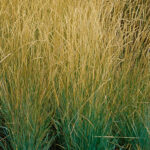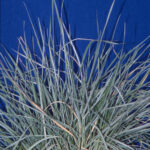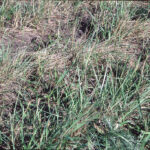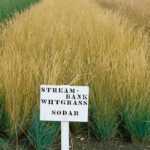Streambank Wheatgrass
Elymus lanceolatus spp. psammophilus
General Description
Streambank wheatgrass is a low growing, highly rhizomatous grass that spreads out to form a tough sod. Streambank wheatgrass is now considered a subspecies of northern wheatgrass. While considered a native grass, tame cultivars have been developed and used for over 65 years. Streambank wheatgrass has moderately short stems and seedheads and tough, narrow leaves. Streambank wheatgrass may be used for pasture, but has relatively low production and palatability.
Type
Native grass & tame grass. Long standing tame cultivars exist.
Origin
Native to riparian and moist areas across the prairies. Tame varieties developed in Canada and USA.
Longevity
Long-lived.
Use
Reclamation, pasture. Streambank sub-species is best noted for reclamation.
Optimal Time of Use
Spring, summer. If grazed, streambank wheatgrass should be used early as palatability decreases as it matures.
Recovery After Use
Cultivars require an average of 60-80 days of recovery after use. Streambank wheatgrass regrowth potential is generally low.
Palatability/Nutritional Value
Streambank wheatgrass has low palatability. Average digestibility of 54% and crude protein of 9% are noted in the late vegetative stage.
Annual Precipitation min/max (mm)
203mm / 635mm
Drought Tolerance
Excellent tolerance.
Flooding Tolerance
Withstands up to 5 weeks of flooding.
Winter Hardiness
Good hardiness.
Soil Texture Preference
Streambank wheatgrass is adapted to well to moderately drained sandy, loamy and clay soils in the Brown, Dark Brown, Black and Grey soil zones.
Erosion Control
Streambank wheatgrass is highly effective for water erosion control. It can be used in streams, canals, and erosion gullies. Streambank wheatgrass is short and does not impede water flow.
Salinity Tolerance
Moderate tolerance.
Acidity Tolerance
Not recommended for use on acidic soils.
Alkalinity Tolerance
Moderate tolerance.
Seeds per kg
354,000 seeds/kg (160,000 seeds/lb)
Suggested Mixtures
Streambank wheatgrass is often seeded as a monoculture on waterways. Streambank wheatgrass can be used with other vigorous native species for reclamation. Sodar is the long-standing streambank wheatgrass cultivar.
Ease of Establishment
Streambank wheatgrass has good establishment vigor. It is one of the most vigorous native seedlings next to slender wheatgrass. Rhizomes grow quickly to spread the plant outwards.
Competitiveness
Streambank wheatgrass is more vigorous than northern wheatgrass. It is very competitive overall once established and is noted for competing with weeds. Aggressive tame forage species may compete with streambank wheatgrass.
Management Considerations
Streambank wheatgrass will form a low growing, highly rhizomatous sod noted for lower leaf production. Seed in areas where the grasses specific characteristics are needed for the planting site.
Saskatchewan Dryland Forage Species Adaptation Tool, AAFC Field Guide to Selected Native Forages, USDA Plants Database, Alberta Forage Manual



